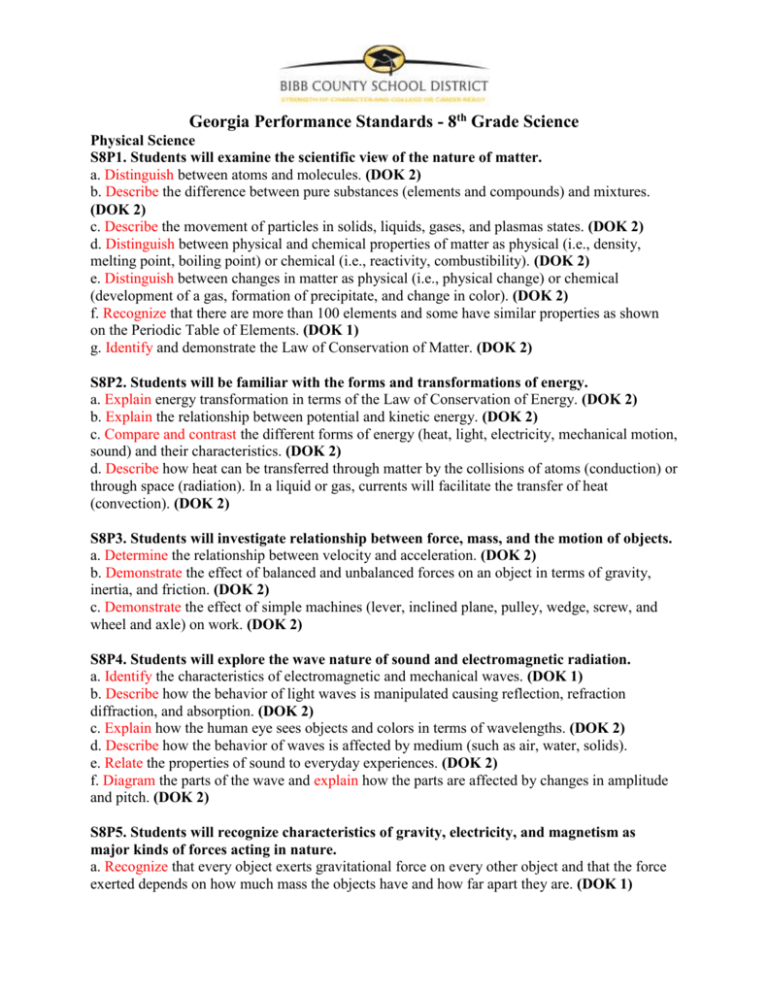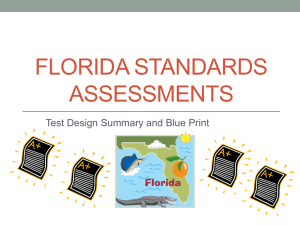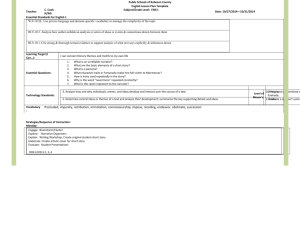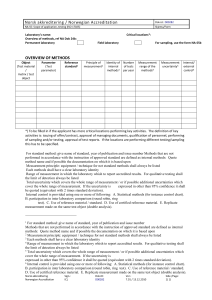Eighth Grade Science Standards
advertisement

Georgia Performance Standards - 8th Grade Science Physical Science S8P1. Students will examine the scientific view of the nature of matter. a. Distinguish between atoms and molecules. (DOK 2) b. Describe the difference between pure substances (elements and compounds) and mixtures. (DOK 2) c. Describe the movement of particles in solids, liquids, gases, and plasmas states. (DOK 2) d. Distinguish between physical and chemical properties of matter as physical (i.e., density, melting point, boiling point) or chemical (i.e., reactivity, combustibility). (DOK 2) e. Distinguish between changes in matter as physical (i.e., physical change) or chemical (development of a gas, formation of precipitate, and change in color). (DOK 2) f. Recognize that there are more than 100 elements and some have similar properties as shown on the Periodic Table of Elements. (DOK 1) g. Identify and demonstrate the Law of Conservation of Matter. (DOK 2) S8P2. Students will be familiar with the forms and transformations of energy. a. Explain energy transformation in terms of the Law of Conservation of Energy. (DOK 2) b. Explain the relationship between potential and kinetic energy. (DOK 2) c. Compare and contrast the different forms of energy (heat, light, electricity, mechanical motion, sound) and their characteristics. (DOK 2) d. Describe how heat can be transferred through matter by the collisions of atoms (conduction) or through space (radiation). In a liquid or gas, currents will facilitate the transfer of heat (convection). (DOK 2) S8P3. Students will investigate relationship between force, mass, and the motion of objects. a. Determine the relationship between velocity and acceleration. (DOK 2) b. Demonstrate the effect of balanced and unbalanced forces on an object in terms of gravity, inertia, and friction. (DOK 2) c. Demonstrate the effect of simple machines (lever, inclined plane, pulley, wedge, screw, and wheel and axle) on work. (DOK 2) S8P4. Students will explore the wave nature of sound and electromagnetic radiation. a. Identify the characteristics of electromagnetic and mechanical waves. (DOK 1) b. Describe how the behavior of light waves is manipulated causing reflection, refraction diffraction, and absorption. (DOK 2) c. Explain how the human eye sees objects and colors in terms of wavelengths. (DOK 2) d. Describe how the behavior of waves is affected by medium (such as air, water, solids). e. Relate the properties of sound to everyday experiences. (DOK 2) f. Diagram the parts of the wave and explain how the parts are affected by changes in amplitude and pitch. (DOK 2) S8P5. Students will recognize characteristics of gravity, electricity, and magnetism as major kinds of forces acting in nature. a. Recognize that every object exerts gravitational force on every other object and that the force exerted depends on how much mass the objects have and how far apart they are. (DOK 1) Georgia Performance Standards - 8th Grade Science b. Demonstrate the advantages and disadvantages of series and parallel circuits and how they transfer energy. (DOK 2) c. Investigate and explain that electric currents and magnets can exert force on each other. (DOK 2)









